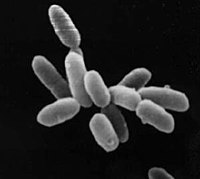
Photo from wikipedia
Halobacterium salinarum R1 is an extremely halophilic archaeon capable of adhesion and forming biofilms, allowing it to adjust to a range of growth conditions. We have recently shown that living… Click to show full abstract
Halobacterium salinarum R1 is an extremely halophilic archaeon capable of adhesion and forming biofilms, allowing it to adjust to a range of growth conditions. We have recently shown that living in biofilms facilitates its survival under Cu2+ and Ni2+ stress, with specific rearrangements of the biofilm architecture observed following exposition. In this study, quantitative analyses were performed by SWATH mass spectrometry to determine the respective proteomes of planktonic and biofilm cells after exposition to Cu2+ and Ni2+.Quantitative data for 1180 proteins were obtained, corresponding to 46% of the predicted proteome. In planktonic cells, 234 of 1180 proteins showed significant abundance changes after metal ion treatment, of which 47% occurred in Cu2+ and Ni2+ treated samples. In biofilms, significant changes were detected for 52 proteins. Only three proteins changed under both conditions, suggesting metal-specific stress responses in biofilms. Deletion strains were generated to assess the potential role of selected target genes. Strongest effects were observed for ΔOE5245F and ΔOE2816F strains which exhibited increased and decreased biofilm mass after Ni2+ exposure, respectively. Moreover, EPS obviously plays a crucial role in H. salinarum metal ion resistance. Further efforts are required to elucidate the molecular basis and interplay of additional resistance mechanisms.
Journal Title: Frontiers in Microbiology
Year Published: 2019
Link to full text (if available)
Share on Social Media: Sign Up to like & get
recommendations!